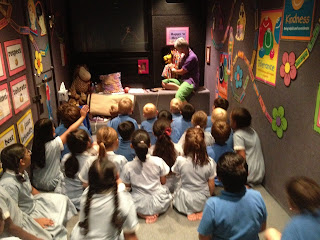Children's Writing - Room 6
The children have been learning to improve their story writing by planning their writing first and then adding interesting character and setting descriptions.Angelina has done a great x-chart plan for her character description that includes what the character looks like, sounds like, smells like and feels like (or makes us feel). She has then written a few clear sentences from her plan about her pirate character.
Willem described his character Edward using his plan on the previous page.
Children plan and write over two days, usually, and then re-read their work checking it against the rubric or success criteria to see if they have everything they need.
Children's Concept/ Topic Writing
This term the concept at St Mary's School is communities. Room six have been discussing and thinking about the roles and responsibilities people have in the different communities that they belong to. They have also been looking at the word interdependence - where everybody in a community depends on everybody else to perform their role so that the community runs smoothly. We then started looking at how ant communities work through interdependence. The children did some explanation writing to explain how one particular kind of ants works with another insect, the aphid, in a community. The relationship of the ant and aphid is said to be one of 'symbiosis'. In the ant and aphid community the ants and aphids show interdependence.
Some of the children's writing is shown published below:
Some of the children's writing is shown published below:
Ants and Aphids by Alex
IN THE FOREST ARE ANTS AND APHIDS . ANTS CRAWL AROUND LOOKING FOR FOOD. DO YOU THINK ANTS EAT APHIDS NO, APHIDS HELP ANTS AND ANTS HELP APHIDS . BEACAUSE APHIDS MAKE HONEY DUE FOR THE ANTS TO KEEP GOING. APHIDS EAT FLOWERS. NEXT WHEN ALL THE APHIDS EAT THE FLOWERS THE ANTS TAKE THE APHIDS TO ANOTHER FLOWER . When the aphids are eating the flower the ant goes and finds some food when they suddenly find lady bug eggs. Next a giant ladybug comes but the ant scares it off with its jaws.
Ants and Aphids by Kim
Ants protect aphids so aphids will give them honeydew. I also learnt that aphids got the honeydew from the leaf. If the plant is dead the ants will move them to another Plant. One of the words I learnt is symbiosis. Ants give aphids these kind of medicine so they won’t get some kinds of diseases. They lick the aphids and that’s how they make aphids stay alive. When a ladybird comes it will try to harm the aphids. If it does the ant will hurt it back and eat its egg for a treat . If the aphid all die ants will all die because ants cannot get any honeydew. Ants let aphids go to there colony for winter.
Ants and Aphids by Ria
Ants and aphids are
partners, they work together. Ladybugs like to eat aphids so ants look after
aphids and protect them, this is called symbiosis. Aphids suck juice from
plants, and ants take honeydew from the aphids. When aphids get diseases ants
put saliva on their bodied to protect them.
Ants and Aphids by Naina
Ants are very small, they look after aphids, they are
like there sheep. Aphids suck roses crisanthanems and when the ants scrape the
aphids backs the ants get sweet juice called honeydew. The ants also help the
aphids from a disease called fungus. When a large predator like a ladybug comes
an ant would bite with it’s manibles and the ladybug flies away. Ants form a
big community in India
Ants and Aphids by Misty
Ants and Aphids
work together as a team. Ants protect aphids by keeping predators away by
nipping them with their jaws. Their jaws
are really big .Aphids make honeydew for ants. Ants make sure that aphids are
clean. Ants lick them and always protect them from anything. Do you think that
ants will kill them? Not at all.



































